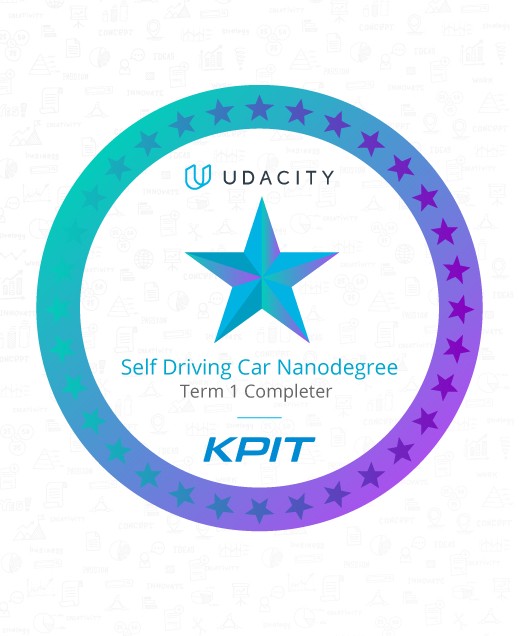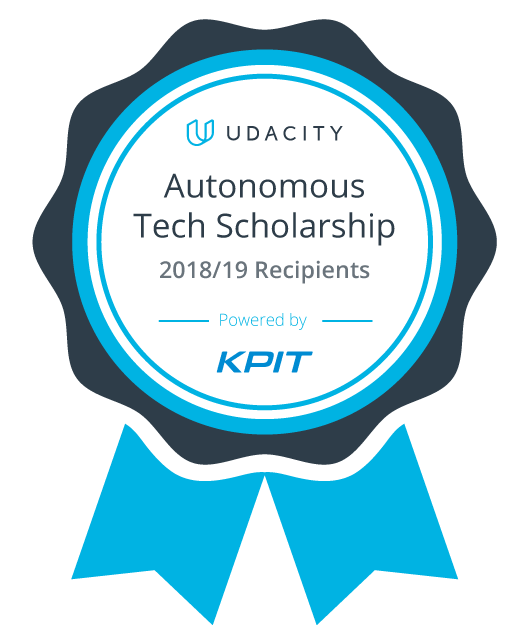Udacity KPIT Scholarship Program

Udacity offers several scholarship programs in partnership with leading technology companies like Google, Facebook, KPIT. I got a chance to apply for one of their recent scholarship programs — Udacity KPIT Autonomous Tech Scholarship. As part of this program, the scholars who get accepted will have access to Udacity’s Self Driving Car Nanodegree Term1 course. After 2 weeks of waiting, I got the confirmation mail that I have been accepted to the scholarship program! This was a big opportunity as the scholarship program not only gives access to a very interesting course from Udacity but also gives the chance to interview for KPIT.

Since this was a scholarship program which was given to a few hundred applicants out of thousands who applied, the accepted scholars need to meet some course requirements. While the regular nanodegree students get 3 months to finish Term1 of the course, we as scholars get 2 months to finish the course with strict deadlines for projects completion. If you are a college going student or have a full time job, this can make your schedule super busy. But still, you don’t want to lose the opportunity when it comes knocking on your doors right? “If a window of opportunity appears, don’t pull down the shade.” — these are not my words but Tom Peters’.
Until a few years ago, news or discussions about self driving cars or autonomous vehicles were not often heard about. That has now changed drastically, with laws being made and several states from some countries already allowing testing of self driving cars(even without a safety driver). Automobiles has been one of those industries which took a leap forward with the help of recent technology advancements. Whether or not you own/ride an SDC in the near future, it is informative to know its building blocks and understand different technologies that are involved. Through several lessons and 5 projects, the course gave us enough to know a lot about all that.
The distinguishing feature of an autonomous vehicle is its ability to see and know the world around it with the help of cameras and sensors. This enables the vehicle to capture large amounts of real world data. The data is then processed and used for perception and decision making. All of this makes Computer Vision a key component for aiding the self driving cars and vehicles. For example, self driving cars depend on lane detection to navigate and drive.
Fully automated vehicle replaces the human driver with an empty seat. For that, we need an autonomous system which can mimic human driver besides other things. This is where Behavioral Cloning comes in. Using the data collected from a car driven by a human, a neural network can be trained to learn to mimic the human’s driving. Though this is doable, the trained model will be as good as the kind of scenarios it possibly comes across from the training data. But don’t we have access to tons of data? Yes, we do. The problem with applying Deep Learning is that more often than not the data collected will not capture all real time scenarios. For example, to avoid crashes and accidents, the model needs to be fed such scenarios from the data. For reasons like these, researchers feel there is still time for Machine Learning to completely take over the rule-based systems when it comes to autonomous vehicles.
Though I did take some Udacity courses before, this scholarship program besides helping me a lot in knowing more about how self driving cars work, gave me an opportunity to be part of a learning community and to get feedback for my work and projects. I have to thank the course instructors David Silver, Ryan Keenan etc and Udacity Support Team who were available on Slack for any help we needed. Thanks to all my project reviewers who kindly acknowledged my request to share any references to improve my projects by providing many useful resources and comments. Thanks to KPIT for sponsoring this program which already benefited hundreds of students and learners. It’s amazing how accessible it is to learn new and upcoming technologies from the best researchers in the field and from the best organizations. A big thanks to Udacity and Udacity India for having courses and scholarship programs which bring together students, job seekers and leading companies.
Terramax, Darkhorse, Highlander, Sandstorm, Stanley and few others were all ready for a race. The path was not a smooth racing track and the racers were driven by code! Curious to know who won? Watch The Great Robot Race. Thanks to Sebastian Thrun for all his courses and contributions!
<br/>
Did you find this post useful? Head over here and give it a clap(or two 😉 ). Thanks for reading 😄 😄
Leave a Comment